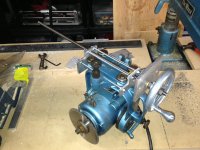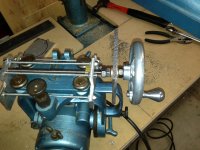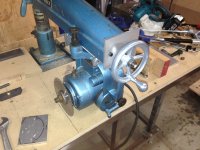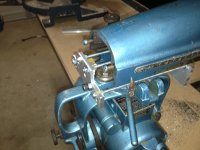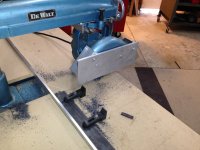downsizingnow48
Elite Member
Nobody is more interested in keeping all my original parts intact than me. So I appreciate various safety comments. Bukit and Stopper have made specific suggestions on clamping. Will revisit the clamping arrangement (currently one milling machine clamp) and make use of two sturdy holddowns. I believe other important questions raised about blade speed and push/pull have been resolved. Have installed a full shroud for additional safety.
To clarify one point. I am not using the RAS to save money, or for convenience. True, I am a believer in build it yourself rather than buy it yourself. But in this case I didn't find anything that would do the job so buy wasn't an option. I read every thread on metal cutting on TBN (there are lots of excellent posts). Have also checked out a couple other forums. Did not see a tool identified (up to light commercial scale) that would leave a perfectly square finished edge on mild 1/2" steel up to 12-16" wide with easy setup, no-measurement repetitive cuts, and no cleanup grinding. The modified RAS does that. I could have missed something though.
I will get some square tubing and try the bevel cuts described by Bukit, and the compound cuts described by Stopper, to see if it will meet those requirements too.
The issue on bevel and compound cuts of course is controlling the feed. Hand held RAS, as several have pointed out - and my own experience is the same - is difficult enough on wood.
I believe I can install a lead screw/handwheel arrangement in the cast iron arm, similar to a lathe or milling machine. Have ordered the parts. That will allow precise slow movement of motor head and blade into the work and address the grab/jump/kickback questions that have been raised. I will provide an update on that after installation.
In the meantime my wife and I are headed to the coast for a week of vacation after all the holiday family visits. So if I am incommunicado for a while it is definitely not for lack of interest. Many thanks.
To clarify one point. I am not using the RAS to save money, or for convenience. True, I am a believer in build it yourself rather than buy it yourself. But in this case I didn't find anything that would do the job so buy wasn't an option. I read every thread on metal cutting on TBN (there are lots of excellent posts). Have also checked out a couple other forums. Did not see a tool identified (up to light commercial scale) that would leave a perfectly square finished edge on mild 1/2" steel up to 12-16" wide with easy setup, no-measurement repetitive cuts, and no cleanup grinding. The modified RAS does that. I could have missed something though.
I will get some square tubing and try the bevel cuts described by Bukit, and the compound cuts described by Stopper, to see if it will meet those requirements too.
The issue on bevel and compound cuts of course is controlling the feed. Hand held RAS, as several have pointed out - and my own experience is the same - is difficult enough on wood.
I believe I can install a lead screw/handwheel arrangement in the cast iron arm, similar to a lathe or milling machine. Have ordered the parts. That will allow precise slow movement of motor head and blade into the work and address the grab/jump/kickback questions that have been raised. I will provide an update on that after installation.
In the meantime my wife and I are headed to the coast for a week of vacation after all the holiday family visits. So if I am incommunicado for a while it is definitely not for lack of interest. Many thanks.
